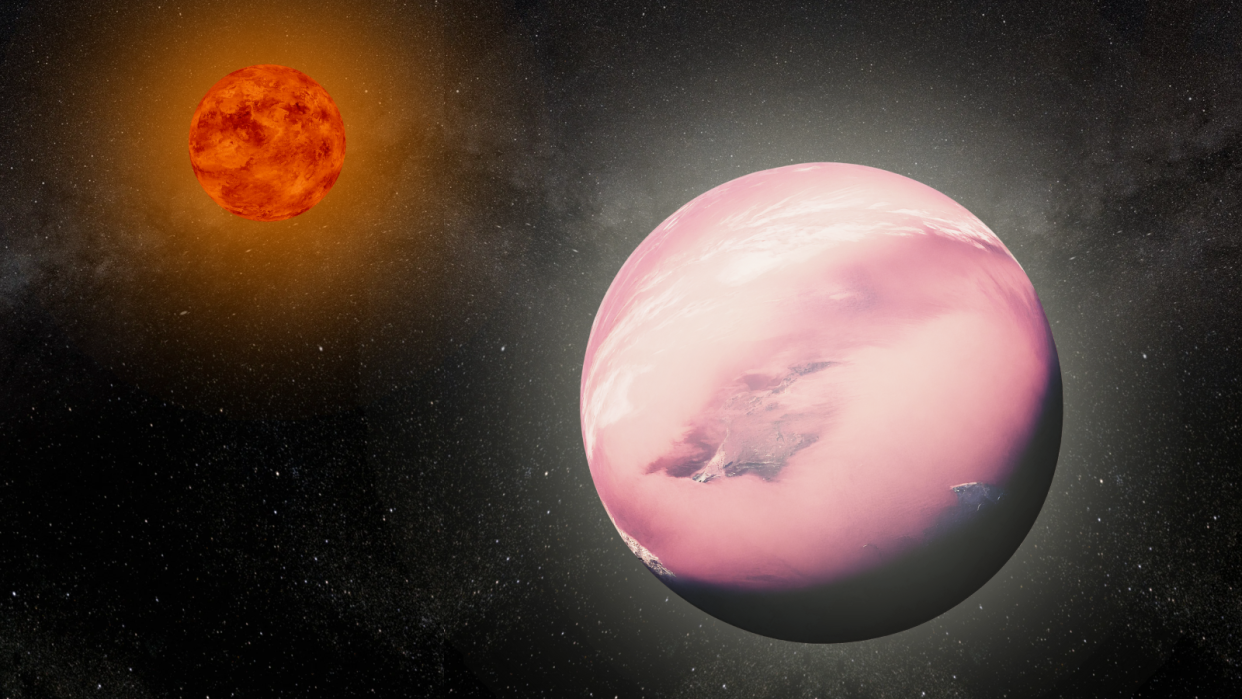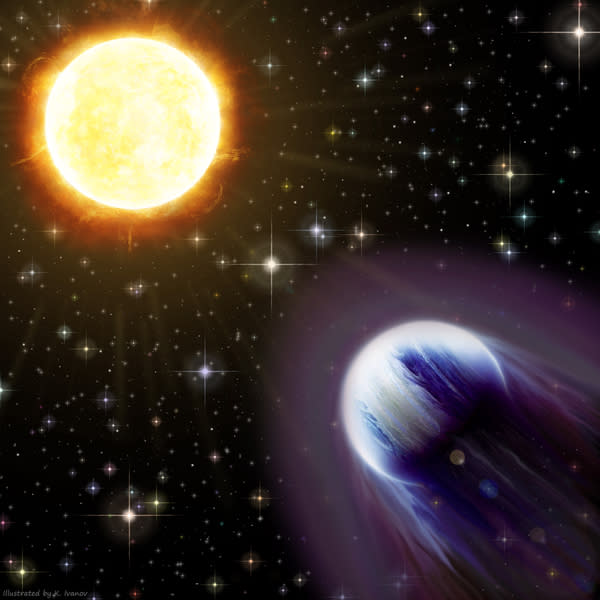Cotton candy exoplanet is 2nd lightest planet ever found

Astronomers have discovered a new planetary oddball beyond the solar system that is as fluffy and light as cotton candy.
The extrasolar planet or "exoplanet" named WASP-193 b is around 1.5 times the width of Jupiter but has just over a tenth of the solar system gas giant's mass. This makes it the second-lightest planet in the exoplanet catalog, which contains over 5,400 entries. Only the Neptune-like world, Kepler 51 d, is lighter than WASP-193 b.
Located around 1,200 light-years from Earth, WASP-193 b orbits its star at a distance of around 6.3 million miles, which is about 0.07 times the distance between Earth and the sun. That means it completes an orbit of its sun-like star, WASP-193, in just 6.2 Earth days.
The discovery of WASP-193 b adds to the wide and wonderful variety of planets outside the solar system, which, in this case, could help scientists redefine models of how planets form.
Related: Some planets 'death spiral' into their stars and scientists may now know why
"To find these giant objects with such a small density is really, really rare," discovery team co-leader and Massachusetts Institute of Technology (MIT) postdoc Khalid Barkaoui said in a statement. "There's a class of planets called puffy Jupiters, and it's been a mystery for 15 years now as to what they are. And this is an extreme case of that class."
Fluffy world is an "outlier" to planet formation models
The MIT team found WASP-193 b using the Wide Angle Search for Planets (WASP) system composed of two robotic observatories and telescope arrays, one in the northern hemisphere and the other in the southern hemisphere.
WASP identified the puffy gas giant planet using tiny dips in starlight caused as it crossed or "transited" the face of it star. These transits also allowed researchers to determine the planet's plus-Jupiter size and its orbital period (how long it takes to complete one trip around its star).
The mass of WASP-193 b was determined by observing the gravitational tug it exerts on its star as it orbits. This causes a "wobble" in the star's motion, which manifests as a shift in the wavelengths of light coming from it. The magnitude of the distortion tells scientists the mass of the planet. In this case, however, WASP-193 b is so light that its pull on its star isn't discernible using this "radial velocity" method.
"Typically, big planets are pretty easy to detect because they are usually massive and lead to a big pull on their star," team member Julien de Wit, an assistant professor in MIT’s Department of Earth, Atmospheric and Planetary Sciences, said. "But what was tricky about this planet was, even though it's big — huge — its mass and density are so low that it was actually very difficult to detect with just the radial velocity technique. It was an interesting twist."
It took four years of observations with WASP to get a tiny but detectable "wobble" signal from this star and determine the mass of this orbiting gas giant exoplanet. This confirmed WASP 193 b is so "fluffy" that it challenges concepts of planet formation.
"We were initially getting extremely low densities, which were very difficult to believe in the beginning," team co-leader Francisco Pozuelos, a senior researcher at the Institute of Astrophysics of Andalucia, said. "We don't know where to put this planet in all the formation theories we have right now because it's an outlier of all of them.
"We cannot explain how this planet was formed based on classical evolution models."

To get a picture of just how light and fluffy WASP-193 b is, Earth has a density of 5.5 grams per cubic centimeter, while the solar system gas giant Jupiter has a density of around 1.3 grams per cubic centimeter. WASP-193 b has a density of just 0.059 grams per cubic centimeter. Cotton candy is roughly analogous because it has a density of around 0.05 grams per cubic centimeter.
"The planet is so light that it's difficult to think of an analogous, solid-state material," Barkaoui explained. "The reason why it's close to cotton candy is because both are mostly made of light gases rather than solids. The planet is basically super fluffy."
The team thinks that WASP-193 b is composed of mostly hydrogen and helium like Jupiter and other gas giants. They theorize these gases are forming a massively overinflated atmosphere that is tens of thousands of miles wider than Jupiter's atmosphere.
While the puffed-out atmosphere is likely a result of WASP-193 b being bombarded by radiation from its close star, what the team doesn't yet know is exactly how this super-puffy nature has been maintained by WASP-193 b, as planet formation models don't account for this.
"Looking more closely at its atmosphere will allow us to obtain an evolutionary path of this planet," Pozuelos said.
Related Stories:
— Doomed egg-shaped exoplanet is death-spiraling into its star
— Scientists catch real-life Death Star devouring a planet in 1st-of-its-kind discovery
— Star blows giant exoplanet's atmosphere away, leaving massive tail in its wake
To gather information about WASP-193 b's atmosphere and hopefully reveal the secrets of its origins, the team will turn to a technique developed by de Wit. This technique also uses the dips in starlight a planet causes as it transits the face of its star to determine atmospheric characteristics like temperature, composition, and pressure at various depths.
The team also thinks that WASP-193 b could be an ideal exoplanet target for the James Webb Space Telescope (JWST).
"The bigger a planet's atmosphere, the more light can go through," de Wit concluded. "So it's clear that this planet is one of the best targets we have for studying atmospheric effects. It will be a Rosetta Stone to try and resolve the mystery of puffy Jupiters."
The team's research was published on Tuesday (May 14) in the journal Nature Astronomy.

